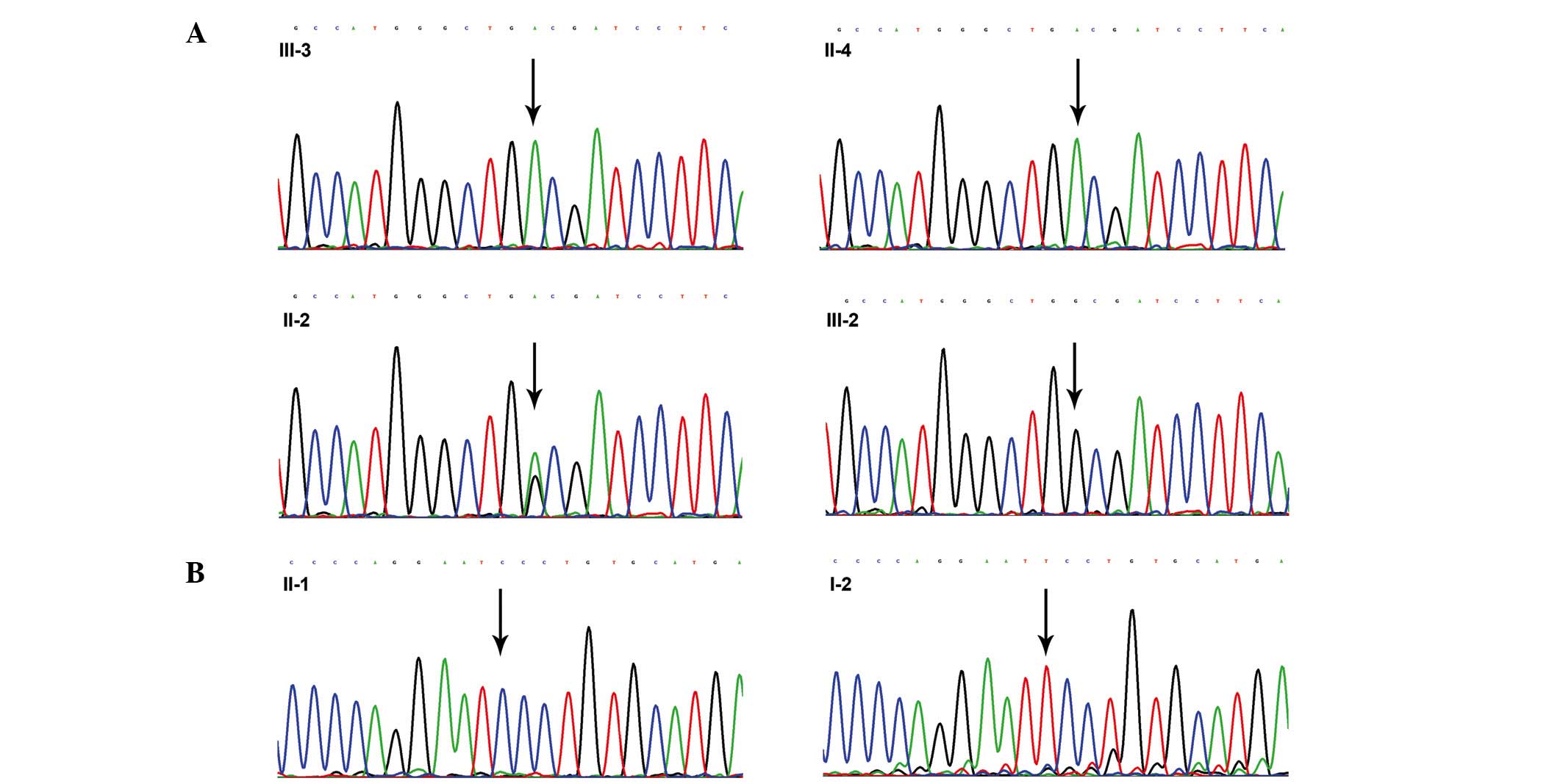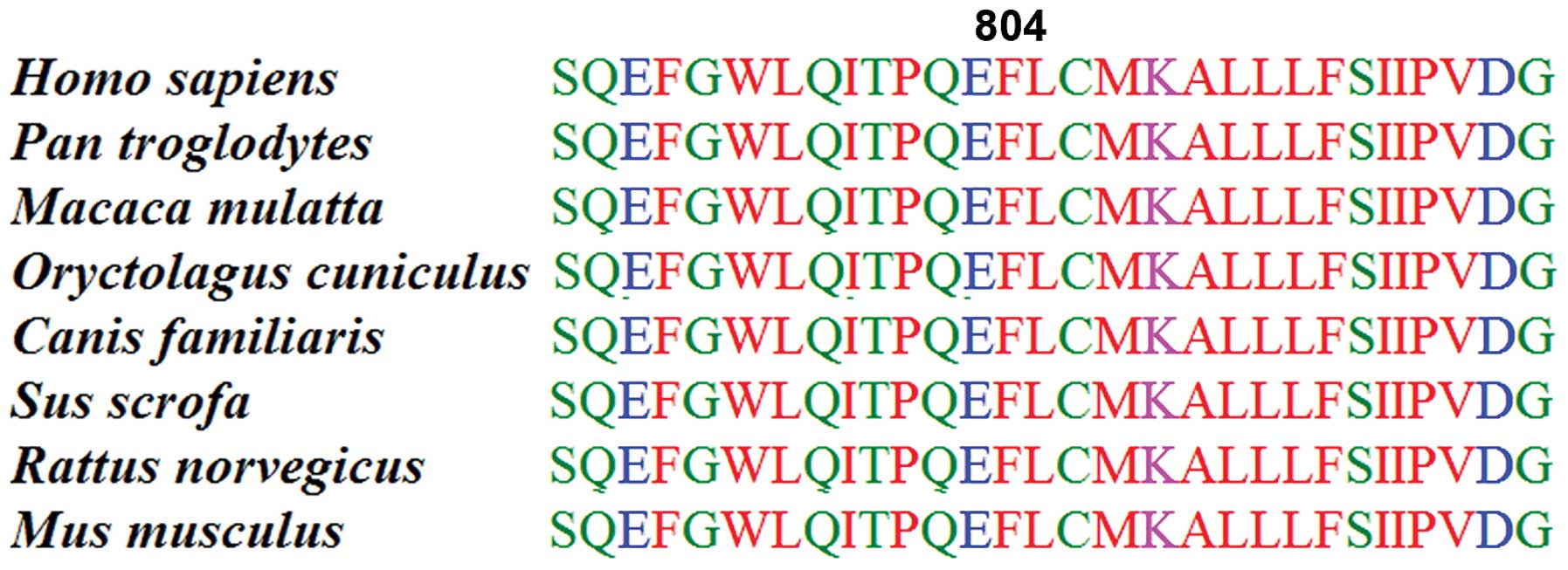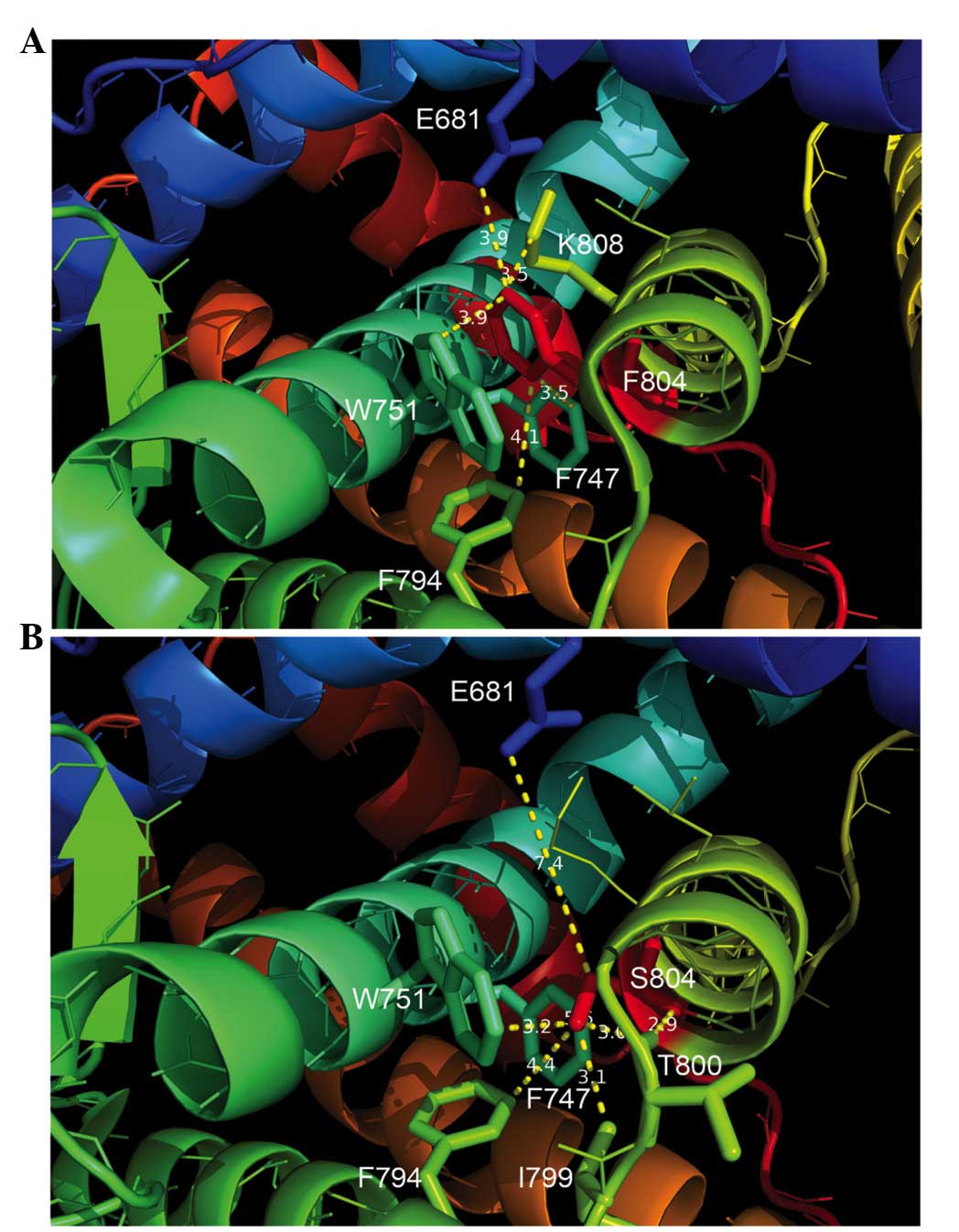|
1
|
Gottlieb B, Lombroso R, Beitel LK and
Trifiro MA: Molecular pathology of the androgen receptor in male
(in)fertility. Reprod Biomed Online. 10:42–48. 2005. View Article : Google Scholar : PubMed/NCBI
|
|
2
|
Rosa S, Biason-Lauber A, Mongan NP,
Navratil F and Schoenle EJ: Complete androgen insensitivity
syndrome caused by a novel mutation in the ligand-binding domain of
the androgen receptor: Functional characterization. J Clin
Endocrinol Metab. 87:4378–4382. 2002. View Article : Google Scholar : PubMed/NCBI
|
|
3
|
Lubahn DB, Joseph DR, Sullivan PM, Willard
HF, French FS and Wilson EM: Cloning of human androgen receptor
complementary DNA and localization to the X chromosome. Science.
240:327–330. 1988. View Article : Google Scholar : PubMed/NCBI
|
|
4
|
Hughes IA, Davies JD, Bunch TI, Pasterski
V, Mastroyannopoulou K and MacDougall J: Androgen insensitivity
syndrome. Lancet. 380:1419–1428. 2012. View Article : Google Scholar : PubMed/NCBI
|
|
5
|
Brinkmann AO: Molecular basis of androgen
insensiticty. Mol Cell Endocrinol. 179:105–109. 2001. View Article : Google Scholar : PubMed/NCBI
|
|
6
|
Morris JM: The syndrome of testicular
feminization in male pseudohermaphrodites. Am J Obstet Gynecol.
65:1192–1211. 1953. View Article : Google Scholar : PubMed/NCBI
|
|
7
|
Decaestecker K, Philibert P, De Baere E,
Hoebeke P, Kaufman JM, Sultan C and T'Sjoen G: A novel mutation
c.118delA in exon 1 of the androgen receptor gene resulting in
complete androgen insensitivity syndrome within a large family.
Fertil Steril. 89:1260.e3–e7. 2008. View Article : Google Scholar
|
|
8
|
Raicu F, Giuliani R, Gatta V, Palka C,
Franchi PG, Lelli-Chiesa P, Tumini S and Stuppia L: Novel mutation
in the ligand-binding domain of the androgen receptor gene (l790p)
associated with complete androgen insensitivity syndrome. Asian J
Androl. 10:687–691. 2008. View Article : Google Scholar : PubMed/NCBI
|
|
9
|
Ahmed SF, Cheng A, Dovey L, Hawkins JR,
Martin H, Rowland J, Shimura N, Tait AD and Hughes IA: Phenotypic
features, androgen receptor binding, and mutational analysis in 278
clinical cases reported as androgen insensitivity syndrome. J Clin
Endocrinol Metab. 85:658–665. 2000. View Article : Google Scholar : PubMed/NCBI
|
|
10
|
Sun S, Luo F, Zhou Z and Wu W: A novel
androgen receptor gene mutation in a Chinese patient with complete
androgen insensitivity syndrome. Eur J Obstet Gynecol Reprod Biol.
153:173–175. 2010. View Article : Google Scholar : PubMed/NCBI
|
|
11
|
Li BK, Ding Q, Wan XD and Wang X: Clinical
and genetic characterization of complete androgen insensitivity
syndrome in a Chinese family. Genet Mol Res. 10:1022–1031. 2011.
View Article : Google Scholar : PubMed/NCBI
|
|
12
|
Cong P, Ye Y, Wang Y, Lu L, Yong J, Yu P,
Joseph KK, Jin F and Qi M: A large deletion/insertion-induced
frameshift mutation of the androgen receptor gene in a family with
a familial complete androgen insensitivity syndrome. Gene.
500:220–223. 2012. View Article : Google Scholar : PubMed/NCBI
|
|
13
|
Hughes IA: Disorders of sex development: A
new definition and classification. Best Pract Res Clin Endocrinol
Metab. 22:119–134. 2008. View Article : Google Scholar : PubMed/NCBI
|
|
14
|
Brown TR1, Lubahn DB, Wilson EM, Joseph
DR, French FS and Migeon CJ: Deletion of the steroid-binding domain
of the human androgen receptor gene in one family with complete
androgen insensitivity syndrome: Evidence for further genetic
heterogeneity in this syndrome. Proc Natl Acad Sci USA.
85:8151–8155. 1988. View Article : Google Scholar : PubMed/NCBI
|
|
15
|
Sultan C, Paris F, Terouanne B, Balaguer
P, Georget V, Poujol N, Jeandel C, Lumbroso S and Nicolas JC:
Disorders linked to insufficient androgen action in male children.
Hum Reprod Update. 7:314–322. 2001. View Article : Google Scholar : PubMed/NCBI
|
|
16
|
Brinkmann AO, Faber PW, van Rooij HC,
Kuiper GG, Ris C, Klaassen P, van der Korput JA, Voorhorst MM, van
Laar JH, Mulder E, et al: The human androgen receptor: Domain
structure, genomic organization and regulation of expression. J
Steroid Biochem. 34:307–310. 1989. View Article : Google Scholar : PubMed/NCBI
|
|
17
|
Gottlieb B, Beitel LK, Nadarajah A,
Paliouras M and Trifiro M: The androgen receptor gene mutations
database: 2012 update. Hum Mutat. 33:887–894. 2012. View Article : Google Scholar : PubMed/NCBI
|
|
18
|
Yaegashi N, Uehara S, Senoo M, Sato J,
Fujiwara J, Funato T, Sasaki T and Yajima A: Point mutations in the
steroid-binding domain of the androgen receptor gene of five
Japanese patients with androgen insensitivity syndrome. Tohoku J
Exp Med. 187:263–272. 1999. View Article : Google Scholar : PubMed/NCBI
|
|
19
|
Köhler B, Lumbroso S, Leger J, Audran F,
Grau ES, Kurtz F, Pinto G, Salerno M, Semitcheva T, Czernichow P
and Sultan C: Androgen insensitivity syndrome: Somatic mosaicism of
the androgen receptor in seven families and consequences for sex
assignment and genetic counseling. J Clin Endocrinol Metab.
90:106–111. 2005. View Article : Google Scholar : PubMed/NCBI
|
|
20
|
Gad YZ, Mazen I, Lumbroso S, Temtamy SA
and Sultan C: A novel point mutation of the androgen receptor
(F804L) in an Egyptian newborn with complete androgen insensitivity
associated with congenital glaucoma and hypertrophic pyloric
stenosis. Clin Genet. 63:59–63. 2003. View Article : Google Scholar : PubMed/NCBI
|
|
21
|
Cheikhelard A, Morel Y, Thibaud E,
Lortat-Jacob S, Jaubert F, Polak M and Nihoul-Fekete C: Long-term
followup and comparison between genotype and phenotype in 29 cases
of complete androgen insensitivity syndrome. J Urol. 180:1496–1501.
2008. View Article : Google Scholar : PubMed/NCBI
|
|
22
|
Matias PM, Donner P, Coelho R, Thomaz M,
Peixoto C, Macedo S, Otto N, Joschko S, Scholz P, Wegg A, et al:
Structural evidence for ligand specificity in the binding domain of
the human androgen receptor. Implications for pathogenic gene
mutations. J Biol Chem. 275:26164–26171. 2000. View Article : Google Scholar : PubMed/NCBI
|
|
23
|
Sack JS, Kish KF, Wang C, Attar RM, Kiefer
SE, An Y, Wu GY, Scheffler JE, Salvati ME, Krystek SR Jr, et al:
Crystallographic structures of the ligand-binding domains of the
androgen receptor and its T877A mutant complexed with the natural
agonist dihydrotestosterone. Proc Natl Acad Sci USA. 98:4904–4909.
2001. View Article : Google Scholar : PubMed/NCBI
|
|
24
|
Ong YC, Kolatkar PR and Yong EL: Androgen
receptor mutations causing human androgen insensitivity syndromes
show a key role of residue M807 in Helix 8-Helix 10 interactions
and in receptor ligand-binding domain stability. Mol Hum Reprod.
8:101–108. 2002. View Article : Google Scholar : PubMed/NCBI
|














